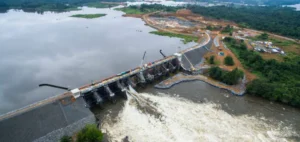Romania’s Ministry of Energy confirms its interest in joining Serbia as an equal partner in the project to build a third hydroelectric power station on the Danube. This project, known as Đerdap III. However, the Ministry also pointed out that discussions are still at a preliminary stage, and that there is currently no joint Romanian-Serbian working group to coordinate the project. Following a meeting with the Romanian ambassador, the Serbian Ministry of Energy announced that teams had been trained in Serbia and Romania for the construction of this hydroelectric plant, andthat the preliminary feasibility studies had been completed. Nevertheless, the Romanian side insisted that the realization of this project would require close cooperation between the two countries and particular attention to environmental impacts and the navigability of the Danube.
An ambitious project with regional implications
The Đerdap III project involves the construction of a reversible hydroelectric power plant on the 1007th kilometer of the Danube. This plant, which will join the two existing ones in the Đerdap system, will bring total capacity to 2,400MW. At present, the two existing hydroelectric plants have a capacity of 1,605MW and contribute 20% of Serbia’s annual electricity production. The Serbian Minister of Energy and Mining, Dubravka Đedović Handanović, and the Romanian Ambassador to Serbia, Silvija Davidoja, discussed the project when they met in Belgrade. According to available information, the Đerdap III project is not only strategic for Serbia and Romania, but also crucial for the region’s energy independence and reduced dependence on external energy suppliers.
Environmental issues and navigability on the Danube
One of the main concerns raised by the Romanian Ministry of Energy is the potential impact of the project on the environment and the navigability of the Danube. The river plays a crucial role in transportation and the regional ecosystem, and any disruption could have significant consequences. The Ministry stressed that these aspects must be carefully studied and taken into account before proceeding with the project. Romania has expressed its willingness to participate in the project, but insists that rigorous environmental assessments and careful planning are required to ensure that the project does not cause irreversible damage. This cautious approach is essential to balance economic and energy benefits with environmental protection.
Economic and energy outlook
The development of Đerdap III represents a significant economic opportunity for Romania and Serbia. By increasing renewable energy production capacity, both countries can enhance their energy security and reduce their dependence on energy imports. What’s more, the project could stimulate the regional economy by creating jobs and attracting investment. The three plants in the Đerdap system will provide a total capacity of 2,400MW, making a substantial contribution to clean energy production in the region. Cooperation between Romania and Serbia is essential for this project, while guaranteeing environmental protection and the navigability of the river.





















